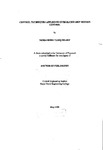CONTROL TECHNIQUES APPLIED TO INTEGRATED SHIP MOTION CONTROL
| dc.contributor.author | SHARIF, MOHAMMED TARIQ | |
| dc.contributor.other | School of Engineering, Computing and Mathematics | en_US |
| dc.date.accessioned | 2013-09-25T08:37:27Z | |
| dc.date.available | 2013-09-25T08:37:27Z | |
| dc.date.issued | 1995 | |
| dc.identifier | NOT AVAILABLE | en_US |
| dc.identifier.uri | http://hdl.handle.net/10026.1/1948 | |
| dc.description.abstract |
Fins stabilisers are devices which are fitted to the hull of a ship and utilised to ameliorate its rolling motions. They apply a regulated moment about the ship's axis of roll in order to oppose the sea induced disturbances. Recognising their unsurpassed performance, the Royal Navy, since the 1950's, equips all its vessels with fin stabilisers. It can be shown that the rudders, in vessels of appropriate size, also have the potential to be harnessed as roll stabilisers Rudder Roll Stabilisation (RRS) without degrading the ship's course-keeping. Thus creating a more stable platform for the human operators and equipment. The reported success of RRS imparted an impetus to the Royal Navy to initiate this study. The objectives are to ascertain whether RRS is possible without rudder modifications and to establish whether enhanced levels of stabilisation would accrue if the fins and RRS were operated in congress. The advantages in this novel approach being: avoidance of redesign and refit of rudders, three modes of operation (fins alone, RRS alone and combined RRS and fins), reduced fin activity and by implication self-generated noise, and amenability to be retrofitted by simple alteration of any existing ship's autopilot software. The study initially examined the mathematical models of the ship dynamics, defining deficiencies and evaluating sources of uncertainty. It was postulated that the dual purpose of the rudder can be separated into non-interacting frequency channels for controller design purposes. An integrated design methodology is adopted to the roll stabilisation problem. Investigating the capabilities of the rudder servomechanism, a new scheme, the Anti-Saturation Algorithm (ASA) was proposed which can eliminate slew rate saturation. Application of the ASA is generic to any servomechanism. The effects of lateral accelerations of the ship on human operators was examined. This resulted in an unique contribution to the Lateral Force Estimator problem in terms of generating time domain models and defining the limitations of the applicability of a control design strategy. Linear Quadratic Guassian and two types of classical controllers were constructed for the RRS and fins. A novel application of linear robust control theory to the ship roll stabilisation problem resulted in H . controllers whose performance was superior to the other design methods. This required the development of weight functions and the identification and quantification of possible sources of uncertainty. The structured singular value utilised this information to give comparable measures of robustness. The sea trials conducted represent the first experience of the integrated ship roll stabilisation approach. Experimental results are detailed. These afforded an invaluable opportunity to validate the software employed to predict ship motion. The data generated from the sea trials concurs with the simulations data in predicting that enhanced levels of roll stabilisation are possible without any modification to the rudder system. They also confirm that when the RRS is acting in congress with the fin stabilisers the activity of both actuators diminishes. | en_US |
| dc.language.iso | en | en_US |
| dc.publisher | University of Plymouth | en_US |
| dc.title | CONTROL TECHNIQUES APPLIED TO INTEGRATED SHIP MOTION CONTROL | en_US |
| dc.type | Thesis | |
| plymouth.version | Full version | en_US |
| dc.identifier.doi | http://dx.doi.org/10.24382/1510 | |
| dc.identifier.doi | http://dx.doi.org/10.24382/1510 |
Files in this item
This item appears in the following Collection(s)
-
01 Research Theses Main Collection
Research Theses Main


